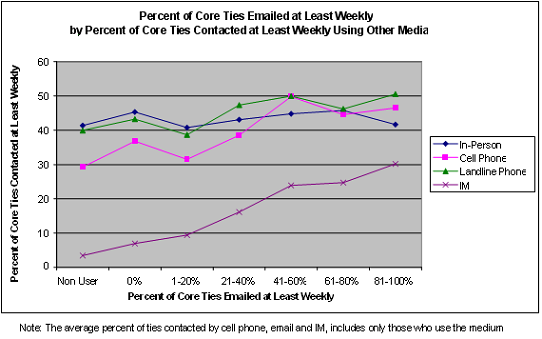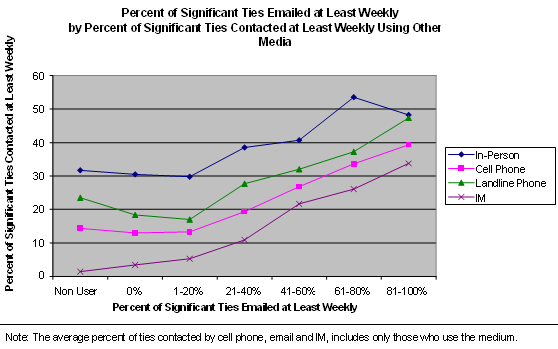Does email substitute for or augment in-person and phone contact?
Since the internet became popular, analysts have wondered about the relationship between email and other means of social contact. Some studies test the replacement hypothesis by examining whether the frequency of email messages sent or received corresponds to decreases (or even increases) in the frequency of in-person or telephone contact.16 Other studies test this hypothesis by measuring time spent online and time spent on other social activities.17 Results from both types of studies have been consistent: The internet does not reduce in-person or telephone contact, or any other form of social activity; it replaces only sleeping or TV watching.
This study examines this issue in a different way. Instead of looking for associations between the frequency or duration of email contact and in-person (or phone) contact, this study looks for associations between the percentages of social ties contacted through various media. If the replacement hypothesis holds true, we would expect that high percentages of social ties contacted by email would be associated with low percentages of social ties contacted through other communication media. This survey has the further advantage of being able to test the replacement hypothesis for core ties and significant ties. For example, Caroline Haythornthwaite and Barry Wellman (1998) found that core ties rely on multiple modes of contact, while significant ties rely on only one or two. By separating core ties from significant ties, we can take into account the strength of the tie when assessing the kinds of communication media used.
Email does not replace other forms of contact for core ties.
Generally, the higher the percentage of core ties that are contacted by email, the higher the percentage of core ties that are contacted by phone and IM. We find the opposite of the replacement hypothesis: There is no evidence that email replaces other forms of contact (Figure 8). To the contrary, those who have weekly email contact with a high percentage of their core and significant ties usually have weekly contact with a high percentage of their ties by phone (landline and cell) and by IM. For example, people who send weekly emails to the great majority (80%–100%) of their core ties are also in weekly landline phone contact with 50% of their core ties. By contrast, those who do not use email are in weekly phone contact with 40% of their core ties. This is an increase of 25% (or 10 percentage points) in phone contact from those who do not email any core ties to those who email almost every core tie at least weekly.
Email contact with core ties does not reduce in-person contact.
The replacement hypothesis also is not supported for in-person contact with core ties: People see about the same number of core ties regardless of whether they email a few or many core ties (Figure 8). The percent of weekly in-person contact does not decrease as the percent of weekly email contact increases. For example, the percentage of core ties seen in-person at least weekly is the same, 41%, for both those who do not use email and for those who email 80%-100% of their core ties at least weekly. These findings are consistent with a 2002 study by Anabel Quan-Haase and Barry Wellman that uses a larger, but less representative, sample.
Email does not replace other forms of contact for significant ties. The higher the percentage of significant ties contacted by email, the higher the percentage of significant ties contacted by other media.
The replacement hypothesis is even more strongly contradicted for significant ties. The greater the percentage of significant ties contacted weekly by email, the greater the percentage of significant ties in that network that are contacted weekly by all other means of communication we surveyed — cell phone, landline phone, IM, and in person. The steep lines in Figure 9 for significant ties show that the positive relationships between emailing and other forms of contact are stronger for significant ties than for core ties.
Heavy email users have more than twice as much landline phone contact and three times as much cell phone contact than email non-users. People who email weekly with almost all of their significant ties (80%-100%) have weekly contact with 48% of their significant ties by landline phone and 47% of their significant ties by cell phone. By contrast, non-users of email have weekly landline phone contact with 23% of their significant ties and cell phone contact with only 14%.
The same pattern holds for in-person contact although the differences are not as marked. Those people who use email for weekly contact with 80%-100% of their significant ties have weekly in-person contact with 48% of their significant ties. By contrast, email non-users have weekly in-person contact with 32% of their significant ties. There is an increase in in-person weekly contact of 50% (or 16 percentage points) between non-email users and heavy users.
There is “media multiplexity”: the more contact by one communication medium, the more by others.
The findings suggest media multiplexity: people who communicate frequently use multiple media to do so. The more contact by one medium, the more contact by others. At this time, we can only speculate as to why.
It could be that one thing leads to another, so that email leads to in-person contact (“let’s get together”) or phone contact (“this is too complicated for email; phone me!”). Similarly, phone conversations can lead to more email (“I’ll send you that joke or web address as soon as I get online”) as can in-person encounters (“It was fun meeting you; let’s keep in touch by email.”). It could be that some social networks are more gregarious than others, so that there is a greater norm and practice of sociability. Or, it could be that some people are more gregariously active in maintaining their networks through frequent communication.
The current generation of email users is communicating more often than recent generations and possibly more often than any previous generation.
Whatever the cause, it is clear that email is adding on to other communication media. This means that the current generation of email users is communicating much more often than recent generations and possibly more often than any previous generation since people huddled in caves with only conversation to pass the nights away. Couple this high rate of communication with the sizable networks we have found, and we have suggestive evidence that while Americans may be bowling alone — as Robert Putnam warned — they are networking together.
Figure 8
Figure 9






